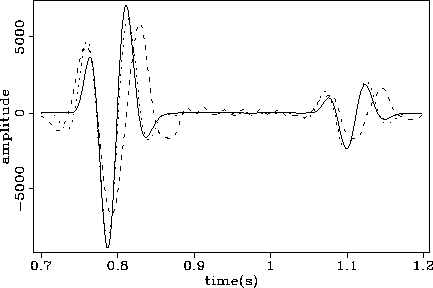




Next: Amplitude versus offset
Up: DYNAMIC BEHAVIOR
Previous: Reflection seismograms from a
The first comparison involves the zero-offset response of the three
methods. A window that includes the first two primary reflections
(both PP) was selected from the zero-offset trace of the vertical
components for the three simulated wavefields. Figure ![[*]](http://sepwww.stanford.edu/latex2html/cross_ref_motif.gif) shows the three waveforms. Except for small differences in the amplitude
and the precursor lobe, the waveforms generated
by the propagator-matrix and dual-operator methods are very
similar. The dispersion is minimal and the kinematics are in accordance
with theoretical expectations. The dispersive character observed in the
wavefield of the traditional finite-difference scheme becomes more clear
in the selected window. As a result of the dispersion, the traveltime
difference between the two reflections (using the central picks as
the measuring criterion) is slightly larger than the theoretical value.
zeroresp
shows the three waveforms. Except for small differences in the amplitude
and the precursor lobe, the waveforms generated
by the propagator-matrix and dual-operator methods are very
similar. The dispersion is minimal and the kinematics are in accordance
with theoretical expectations. The dispersive character observed in the
wavefield of the traditional finite-difference scheme becomes more clear
in the selected window. As a result of the dispersion, the traveltime
difference between the two reflections (using the central picks as
the measuring criterion) is slightly larger than the theoretical value.
zeroresp
Figure 5 Zero offset response generated by the three schemes. The three curves
correspond to a window selected from the first traces of
Figures ![[*]](http://sepwww.stanford.edu/latex2html/cross_ref_motif.gif) -a,
-a, ![[*]](http://sepwww.stanford.edu/latex2html/cross_ref_motif.gif) -a, and
-a, and
![[*]](http://sepwww.stanford.edu/latex2html/cross_ref_motif.gif) -a, which include
the reflections from the first two interfaces of the model. The
continuous line comes from the Haskell-Thomson scheme, the dotted-line
comes from the dual-operator scheme, and the dashed-line
comes from the traditional finite-difference scheme.
-a, which include
the reflections from the first two interfaces of the model. The
continuous line comes from the Haskell-Thomson scheme, the dotted-line
comes from the dual-operator scheme, and the dashed-line
comes from the traditional finite-difference scheme.





The theoretical ratio between the amplitudes of the two reflections is
given by
![\begin{displaymath}
{\mbox{Amp}_2 \over \mbox{Amp}_1} = {R_2 \over R_1} \; (1-R_...
...[{t_1 v_1^2 \over (t_2 - t_1) v_2^2 + t_1 v_1^2} \right]^{1/2},\end{displaymath}](img3.gif)
where the first term is the ratio between the normal incidence reflection
coefficients, the second term is the two-way transmission coefficient, and the
third term is the 2D-divergence relative correction.
The value obtained from the propagator-matrix trace coincides with
the predicted value, while the value from the dual-operator trace is
3.7 percent higher, and the value from the traditional finite-difference
trace is 7.5 percent lower.





Next: Amplitude versus offset
Up: DYNAMIC BEHAVIOR
Previous: Reflection seismograms from a
Stanford Exploration Project
11/18/1997

![[*]](http://sepwww.stanford.edu/latex2html/cross_ref_motif.gif) -a,
-a, ![[*]](http://sepwww.stanford.edu/latex2html/cross_ref_motif.gif) -a, and
-a, and
![[*]](http://sepwww.stanford.edu/latex2html/cross_ref_motif.gif) -a, which include
the reflections from the first two interfaces of the model. The
continuous line comes from the Haskell-Thomson scheme, the dotted-line
comes from the dual-operator scheme, and the dashed-line
comes from the traditional finite-difference scheme.
-a, which include
the reflections from the first two interfaces of the model. The
continuous line comes from the Haskell-Thomson scheme, the dotted-line
comes from the dual-operator scheme, and the dashed-line
comes from the traditional finite-difference scheme.
![\begin{displaymath}
{\mbox{Amp}_2 \over \mbox{Amp}_1} = {R_2 \over R_1} \; (1-R_...
...[{t_1 v_1^2 \over (t_2 - t_1) v_2^2 + t_1 v_1^2} \right]^{1/2},\end{displaymath}](img3.gif)